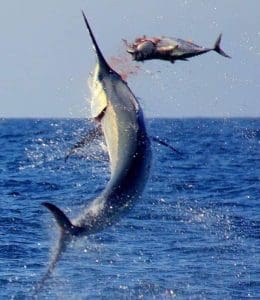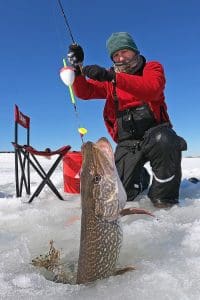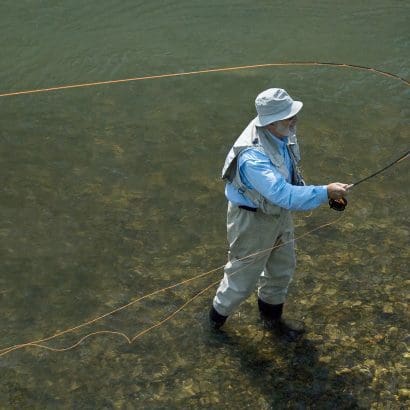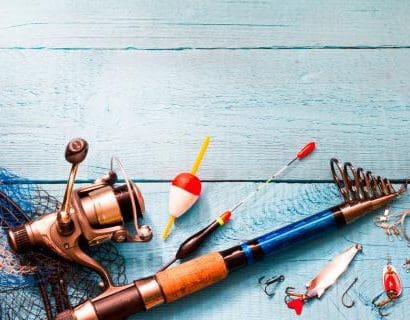
Imagine a sunny morning by the side of a sparkling lake, where the sun is saying ‘hello.’ You, with your fishing gear, all set for a day of adventure! Fishing isn’t just about catching fish; it’s like solving a watery puzzle or going on a treasure hunt in nature. In this article, we’re going to dive into the cool world of sport fishing and check out all the awesome ways people do it. Whether you’re a pro at fishing or just getting started, there’s a way to do it that’ll make you smile. So, grab your fishing gear, and let’s jump into the exciting world of sport fishing!
Contents
Exploring the Art of Fly Fishing.🐟
When it comes to sport fishing, there’s a world of exciting techniques to dive into. One of the most specialized and captivating methods is fly fishing. In this section, we’ll take a closer look at the art of fly fishing, from the gear you’ll need to the ideal spots, and even some basic techniques to get you started on your journey to becoming a fly fishing pro.
The Essence of Fly Fishing
Fly fishing is like the underwater ballet of the fishing world. Instead of using heavy lures and bait, fly anglers rely on delicate and lightweight artificial flies to tempt their catch. These flies are carefully crafted to imitate insects or other aquatic creatures, making them irresistible to certain sport fishing species.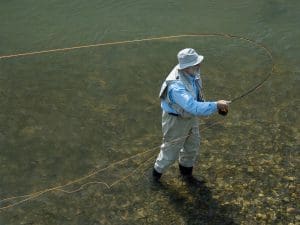
Essential Gear: Rods, Lines, and Flies.
To get started with fly fishing, you’ll need some specific equipment. First up, you’ll want a specialized fly fishing rod, which is longer and more flexible than traditional fishing rods. These rods allow for graceful casting, an essential skill in fly fishing. Your fly line is equally crucial; it’s specially designed to be lightweight and allow for precise casting.
Ideal Spots for Fly Fishing.
Fly fishing is all about precision and finesse, so the choice of location is critical. Typically, you’ll find fly anglers in freshwater environments like rivers, streams, and mountain lakes. These places offer the right conditions for delicate casting and are often abundant with fish species that are particularly receptive to fly lures.
Some iconic fly fishing destinations include the majestic Trout-filled streams of Montana, the serene lakes of the Adirondack Mountains, and even the crystal-clear rivers of New Zealand. These are just a few examples of the many places where fly fishing enthusiasts can cast their lines and connect with nature.
Basic Fly Casting Techniques.
Now, let’s dive into the basics of casting in fly fishing. Picture this: you’re standing knee-deep in a gentle river current, the sun dappling through the trees. To catch that elusive trout, you’ll need to master the art of casting the fly. Here are a few key pointers:
- The Forward Cast: This is the main cast in fly fishing. It involves smoothly swinging your rod backward and then forward, letting the fly line sail through the air towards your target. It’s all about timing and finesse.
- The Roll Cast: When you’re in tight spaces with overhanging trees or rocks behind you, the roll cast comes to the rescue. It’s a low, sweeping motion that keeps your line close to the water’s surface.
- Mending: Sometimes, you’ll need to adjust the position of your line on the water to avoid unnatural drag. This is called mending, and it involves small movements of the rod tip.
Exploring the Thrills of Spinning.🐟
When it comes to what makes fishing a sport, one technique that stands out for its excitement and accessibility is spinning. Whether you’re a seasoned angler or a beginner, spinning offers an engaging way to enjoy the thrill of sport fishing. In this section, we’ll delve into the world of spinning, covering everything from the equipment you’ll need to essential tips for successful casting and retrieval.
Unveiling the Spinning Technique.
Spinning is like the rock star of the sport fishing world. It’s popular, versatile, and it attracts anglers from all corners of the globe. But what exactly is spinning? Well, imagine casting your line with a lightweight, easy-to-handle rod, using a spinning reel that lets you release the line with precision. This technique is particularly renowned for its ease of use, making it a fantastic entry point for those new to where is the best sport fishing in the world.
Essential Gear: Rods, Reels, and Lures.
To embark on your spinning adventure, you’ll need the right tools. Let’s start with the spinning rod—it’s typically shorter and more flexible than other fishing rods, providing you with excellent control for casting and reeling in fish. Pair it with a spinning reel designed for ease of use, and you’ve got a dynamic duo.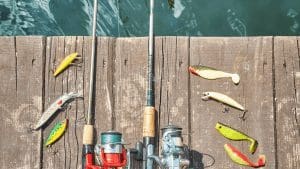
Diving into Lure Types.
Spinning is known for its versatility, and that’s partly thanks to the wide variety of spinning lures available. Here are a few popular choices:
- Jerkbaits: These lures mimic wounded baitfish, making them irresistible to predators like bass and pike.
- Spinnerbaits: With their spinning blades, these lures create vibrations that grab the attention of nearby fish.
- Soft Plastics: These are lifelike, soft-bodied lures that can imitate anything from worms to frogs. They’re great for attracting a wide range of species.
Mastering Casting and Retrieval.
Now, let’s dive into some essential tips for successful spinning. Casting and retrieval are at the heart of this technique, and a bit of finesse can make all the difference:
- The Art of Casting: When you cast, keep your movements smooth and controlled. The spinning reel allows you to release the line with precision, so aim for your target and let it fly.
- Reeling it In: After your cast, start retrieving the lure with a steady and rhythmic motion. Vary your retrieval speed to mimic the movement of prey, which can trigger strikes from hungry fish.
- Setting the Hook: When you feel a strike, don’t yank your rod immediately. Instead, wait for the fish to take the bait fully, then give it a firm hookset to secure your catch.
Embarking on the High Seas.🐟
When it comes to exploring the unknown in sports, few activities can match the excitement of sport fishing in the open sea. It’s like stepping into a realm where the line between human and nature blurs, and every cast of your line is a journey into the unknown. In this section, we’ll set sail on the high seas, exploring the captivating world of offshore sport fishing and revealing the species you can encounter, the specialized gear required, and the essential safety and navigation considerations.
The High Seas Adventure
Imagine this: You’re far from the shore, surrounded by the vast expanse of the ocean. The salty breeze on your face, the sound of seagulls echoing in the distance, and the anticipation of catching something truly remarkable. That’s the essence of offshore sport fishing. It’s not just about fishing; it’s about embracing the thrill of the open sea.
Species that Rule the Depths
Now, let’s talk about the stars of the show—the fish species that roam the deep waters. Offshore fishing offers the chance to reel in some of the ocean’s most sought-after predators, such as marlin, sailfish, tuna, and swordfish. These majestic creatures are known for their strength and speed, making each encounter a test of your angling skills.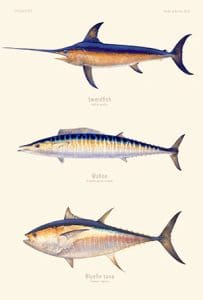
The Gear and Tackle
To conquer the challenges of offshore sport fishing species, you’ll need specialized equipment. Here’s what you should have in your arsenal:
- Deep-Sea Rods and Reels: These are designed to handle the weight and power of large fish. Look for quality reels with strong drag systems to prevent line breakage.
- Heavy-Duty Lines: Opt for strong, durable lines capable of withstanding the brute force of big game fish.
- Baits and Lures: You’ll need a variety of large baits and lures to entice the species you’re targeting. Live baits like mackerel and squid are often used.
- Fighting Chair: When you’re battling a formidable fish, a comfortable fighting chair can make a world of difference.

The open sea is a vast and unpredictable playground. Safety should always be a top priority. Before embarking on your offshore adventure, consider the following:
- Weather Conditions: Keep a close eye on weather forecasts, as conditions can change rapidly at sea. It’s essential to plan your trip during favorable weather windows.
- Safety Equipment: Ensure your boat is equipped with life jackets, flares, a first-aid kit, and communication devices like radios or satellite phones.
- Navigation Skills: If you’re the captain of your fishing expedition, make sure you have the necessary navigation skills or enlist the services of an experienced captain.
- Local Regulations: Familiarize yourself with local fishing regulations, including catch limits and size restrictions, to promote sustainable fishing practices.
Exploring Freshwater Fishing.🐟
In the vast realm of types of sport fishing, freshwater fishing stands out as a diverse and captivating choice. It’s not just about catching fish; it’s about the thrill of fishing for sport in various freshwater habitats, each with its unique charm. In this section, we’ll dive into the world of freshwater fishing, discussing its versatility, different freshwater habitats like rivers, lakes, and reservoirs, common freshwater fish species, and offering some handy tips to make your freshwater angling adventures a success.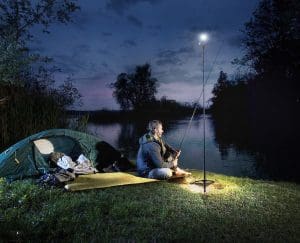
The Versatility of Freshwater Fishing
Freshwater fishing is like a treasure trove of possibilities. It’s an activity that adapts to your preferences, whether you’re seeking tranquility by a quiet riverbank or excitement on a bustling lake. The versatility of freshwater fishing is one of its most enticing features, making it accessible to anglers of all ages and experience levels.
Diverse Freshwater Habitats
Freshwater habitats come in various forms, each offering a distinct experience. Here are some common types:
- Rivers: Flowing waters that wind through landscapes, rivers are home to a wide range of species, including trout, bass, and catfish. Casting your line into a gently moving river can be a serene and rewarding experience.
- Lakes: Lakes are like freshwater playgrounds. They vary in size and depth, and you can find everything from largemouth bass to perch and bluegill. Fishing from a boat or the shoreline, lakes offer abundant opportunities for anglers.
- Reservoirs: Man-made bodies of water created by damming rivers, reservoirs are often stocked with fish like rainbow trout and walleye. They combine the best of both river and lake fishing, with the added intrigue of submerged structures and hidden underwater landscapes.
Common Freshwater Fish Species
Freshwater ecosystems are teeming with life, and you’ll encounter a diverse array of fish species. Some of the most common include:
- Trout: These freshwater favorites are known for their beautiful colors and delicious taste. Species like rainbow, brown, and brook trout can be found in rivers and lakes.
- Bass: Largemouth and smallmouth bass are prized catches among freshwater anglers. They’re known for their strength and are often found lurking in submerged structures.
- Panfish: Species like bluegill, crappie, and perch are perfect for beginners and families. They’re abundant, easy to catch, and make for excellent table fare.
Tips for Successful Freshwater Fishing
Whether you’re a novice or a seasoned angler, these tips can help enhance your freshwater fishing adventures:
- Research: Learn about the specific habitat and fish species you’ll encounter in your chosen location. Understanding their habits and preferences will increase your chances of success.
- Patience: Fishing in freshwater often requires patience. Take your time, enjoy the tranquility, and be prepared to wait for the perfect bite.
- Match Your Gear: Use appropriate tackle and bait for the species you’re targeting. Different fish have different preferences, so be sure to have the right tools.
- Practice Catch and Release: Consider practicing catch and release to help conserve fish populations and ensure future generations can enjoy the same experiences.
Ice Fishing.🐟
In the realm of types of sport fishing, few experiences are as unique and thrilling as ice fishing. It’s a sport that transforms the frozen, snow-covered landscapes of winter into a playground for avid anglers. In this section, we’ll break the ice on the world of ice fishing, covering everything from the specialized equipment required, techniques for drilling holes in the ice, and essential safety precautions. So, bundle up and join us on a journey into the frosty world of ice fishing.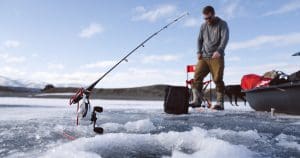
An Introduction to Ice Fishing
Picture a frozen lake, the air crisp and clean, and you, seated on a foldable chair in the middle of a snowy expanse. That’s ice fishing in a nutshell—a serene and captivating activity that brings an entirely new dimension to the world of fishing sport. When the temperatures drop and bodies of water freeze over, it’s time to embrace the magic of ice fishing.
Essential Gear: Ice Rods, Tackle, and Shelters
Ice fishing requires specialized gear to adapt to the unique conditions. Here’s a breakdown of what you’ll need:
- Ice Fishing Rods: These are shorter and more robust than traditional fishing rods, designed to withstand the rigors of icy environments.
- Tackle: You’ll use smaller baits and lures tailored to the preferences of cold-water fish like perch, walleye, and trout.
- Ice Auger: To create fishing holes in the ice, you’ll need an ice auger. You can choose between manual and powered augers, depending on your preference and ice thickness.
- Shelters: When the wind chill becomes too much to bear, portable ice fishing shelters provide protection from the elements and a cozy place to wait for your next catch.

Mastering Ice Fishing Techniques
Ice fishing is all about precision, patience, and understanding the aquatic world beneath the frozen surface. Here are some key techniques to get you started:
- Drilling Holes: The first step is creating holes in the ice to access the water below. Use an ice auger and clear away any ice shavings to ensure a clean fishing hole.
- Tip-Up Fishing: This technique involves setting up a tip-up—a device that signals when a fish has taken the bait. It’s like a flag that pops up when there’s action below the surface.
- Jigging: Jigging is a classic ice fishing method. It involves using small, rhythmic movements to attract fish to your bait. Patience is key, as it can take time for fish to notice your lure.
Safety First: Ice Fishing Precautions
Ice fishing is a rewarding winter activity, but it comes with some risks. Here are essential safety precautions to follow:
- Ice Thickness: Always check the ice thickness before venturing onto a frozen body of water. Four inches of clear ice is generally considered safe for a single person.
- Buddy System: Whenever possible, go ice fishing with a buddy. This adds an extra layer of safety, especially in case of emergencies.
- Safety Equipment: Carry safety gear like ice picks, a life jacket, and a first-aid kit. Be prepared for any unexpected situations.
- Stay Warm: Dress in layers and ensure you’re well-insulated against the cold. Frostbite and hypothermia are real concerns in icy conditions.
Trout Fishing.🐟
In the realm of types of sport fishing, trout fishing shines as a beloved specialty. It’s like a dance with one of the most elusive and sought-after freshwater fish, and anglers around the world are drawn to its challenges and rewards. In this section, we’ll dive into the captivating world of trout fishing, focusing on its popularity, various techniques involving bait and flies, renowned trout fishing destinations, and common seasons and regulations. Plus, if you’re curious about seafood, check out our article “Curiosities about Aphrodisiac Seafood: Myth or Reality?” for a fascinating deep dive.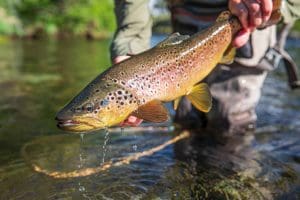
The Allure of Trout Fishing
Trout fishing is like a fine art form within the broader canvas of types of sport fishing. Anglers are captivated by the trout’s cunning nature and the thrill of pursuing these elusive freshwater gems. It’s a sport that demands patience, precision, and a deep understanding of trout behavior.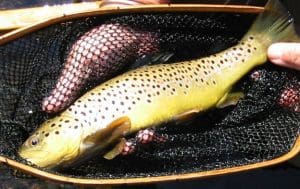
Trout Fishing Techniques: Bait and Flies
Trout are renowned for their selective feeding habits, which means you’ll need to be savvy with your bait and lures. Here are some key techniques to consider:
Bait Fishing: Using live bait like worms, minnows, or power bait can be highly effective for enticing trout. The key is presenting the bait naturally and in a way that mimics the trout’s natural prey.
Fly Fishing: Fly fishing is an art in itself. Anglers use artificial flies, meticulously crafted to imitate insects, to entice trout to bite. It requires finesse in casting and mimicking the fly’s natural movements on the water’s surface.
Iconic Trout Fishing Destinations
Trout fishing can take you to some of the most breathtaking natural settings. Here are a few iconic locations where anglers gather to pursue their passion:
The Rivers of Montana: Montana is famous for its pristine rivers, home to various trout species, including rainbow, brown, and cutthroat trout.
Yellowstone National Park: This treasure trove of natural beauty offers trout fishing amidst stunning landscapes, with cutthroat and brook trout as the stars of the show.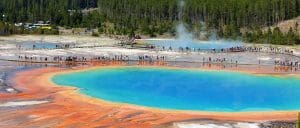
The Rocky Mountains: The Rockies provide countless opportunities for trout fishing, with high-altitude lakes and streams teeming with eager fish.
Seasons and Common Regulations
Trout fishing often follows seasonal patterns, with regulations in place to protect fish populations. It’s crucial to be aware of local rules and conservation efforts. Here are some general guidelines:
- Spring and Fall: Spring and fall are prime trout fishing seasons, as water temperatures are ideal, and trout become more active.
- Catch and Release: Many areas encourage catch and release practices to preserve trout populations, especially for larger and trophy-sized fish.
- Size and Bag Limits: Regulations often specify size and bag limits to ensure sustainable fishing practices.
Harvesting Seafood.🐟
In the vast ocean of sport fishing vs commercial fishing, there exists a fascinating and flavorful subcategory – seafood fishing. It’s a distinctive branch of types of sport fishing where anglers venture into coastal waters to harvest a delectable bounty of oceanic treasures. In this section, we’ll dive into the captivating world of seafood fishing, providing an overview of this sport, the types of seafood you can catch, the equipment and methods involved, as well as the crucial regulations and sustainability practices that ensure our oceans remain abundant with these delectable delights.
Exploring Seafood Fishing
Seafood fishing is akin to a treasure hunt in the ocean, where you become the hunter-gatherer of the underwater world. Unlike traditional sport fishing, where the catch is often released, seafood fishing focuses on reaping the rewards of your maritime endeavors, all while appreciating the ocean’s gifts and respecting its delicate balance.
Varieties of Seafood
The ocean is a vast pantry teeming with culinary delights. Here are some of the delectable seafood treasures you can encounter through seafood fishing:
- Lobster: These delectable crustaceans are a prized catch in many coastal regions. Lobster traps or pots are commonly used to capture them.
- Crab: From Dungeness to blue crab, capturing these scuttling crustaceans is a rewarding endeavor. Crab pots or traps are popular methods for catching crabs.
- Shrimp: Shrimp trawling is a method used to capture these small but flavorful creatures. They are a versatile ingredient in various culinary traditions.
- Mussels and Clams: These filter-feeding mollusks are often harvested using rakes or by hand-picking along coastal shores.
Equipment and Catching Methods
The equipment and methods for seafood fishing are as diverse as the species themselves. Here’s an overview of some common techniques:
- Traps and Pots: Lobster and crab are often captured using traps or pots. These are baited containers that attract the seafood and then keep them trapped.
- Trawling: Shrimp are frequently caught using trawl nets. These nets are dragged along the ocean floor to capture shrimp in large quantities.
- Hand-Picking: Mussels, clams, and other shellfish are often collected by hand-picking along the shorelines during low tide.
Regulations and Sustainability
Seafood fishing, like any form of fishing, must be conducted responsibly to protect marine ecosystems and maintain healthy seafood populations. Regulations vary by region and species, but they typically include:
Catch Limits:
Regulations often specify the quantity of seafood that can be harvested in a given season.
Size Restrictions:
Certain species have size restrictions to ensure that individuals have the opportunity to reproduce before being caught.
Closed Seasons:
Some areas implement closed seasons to protect seafood during critical periods, such as breeding or spawning.
Gear Restrictions:
Regulations may limit the types of gear or methods that can be used to harvest seafood to minimize environmental impact.

